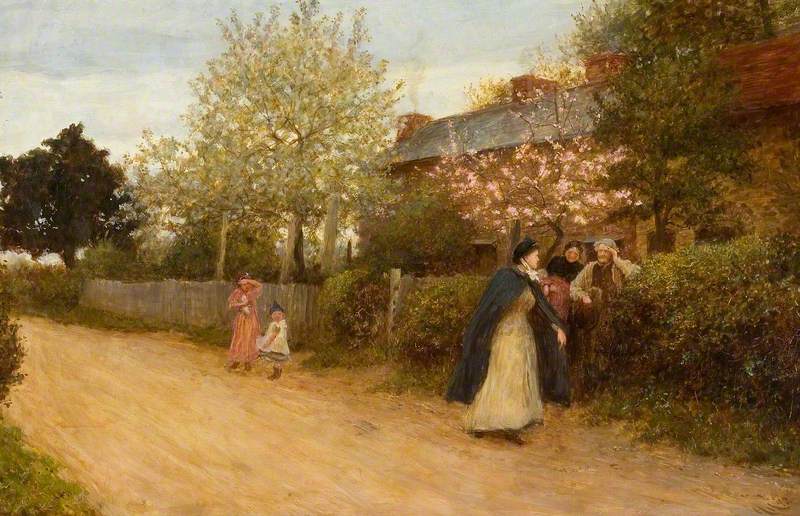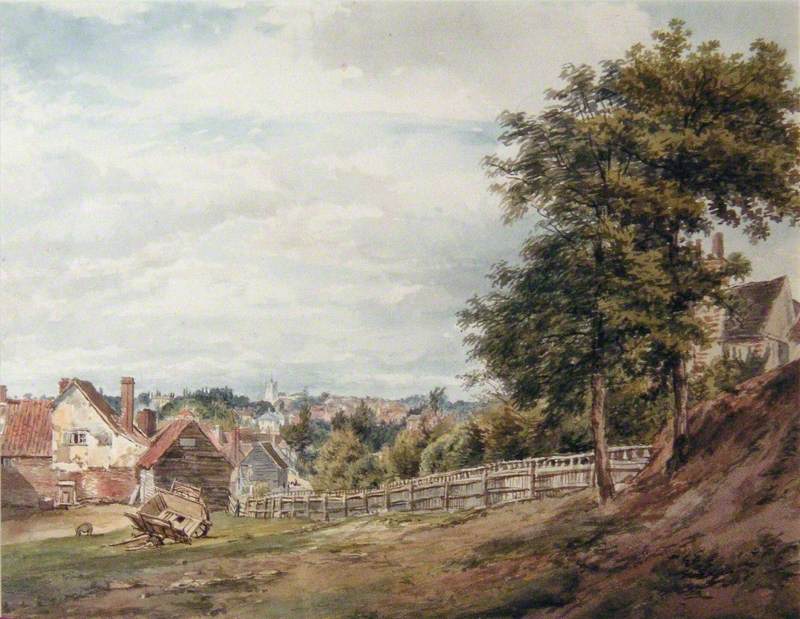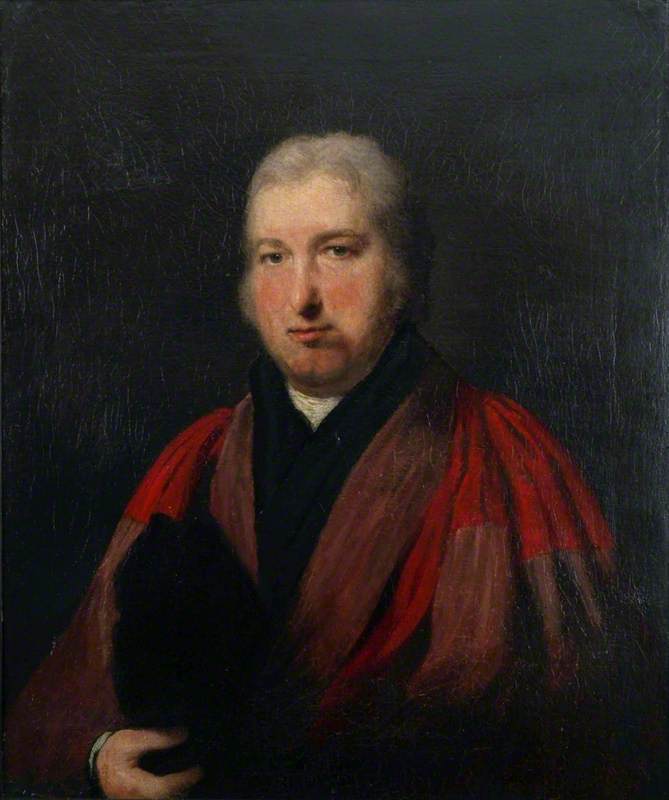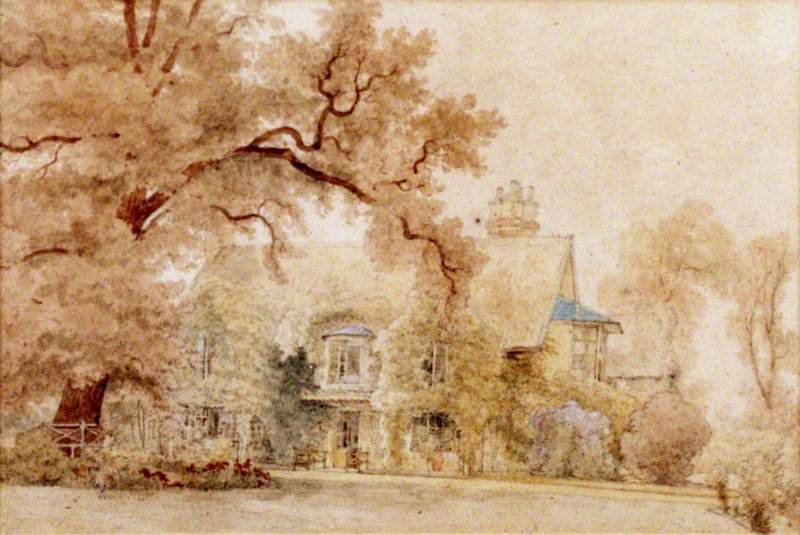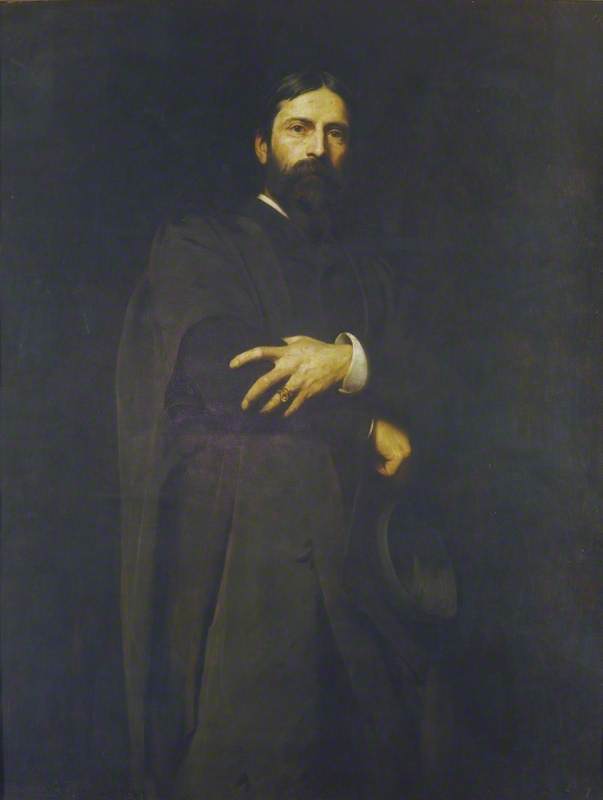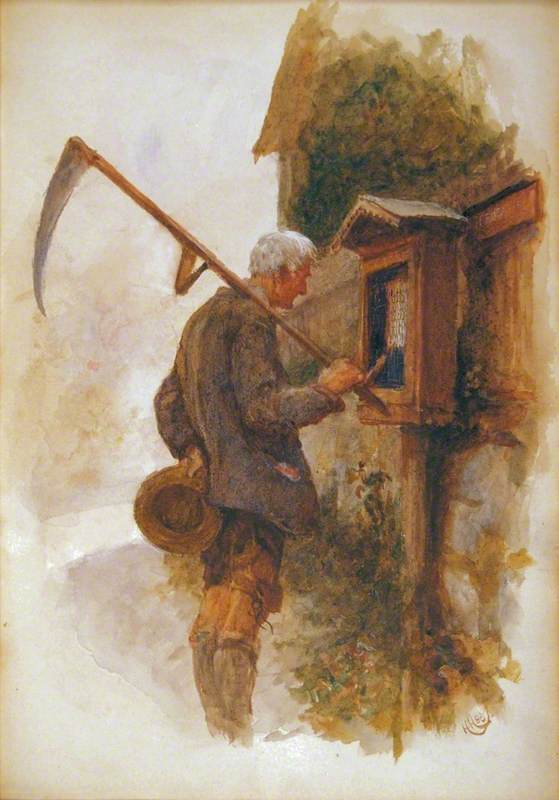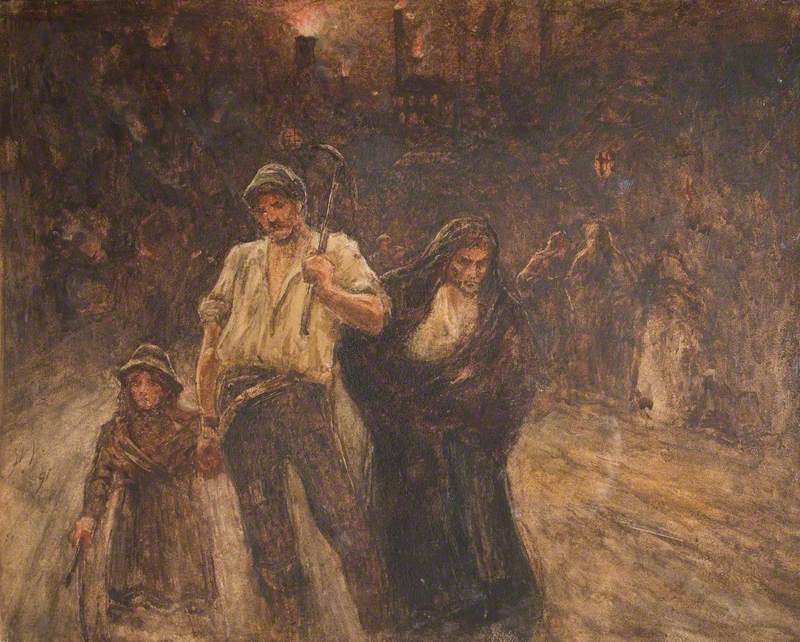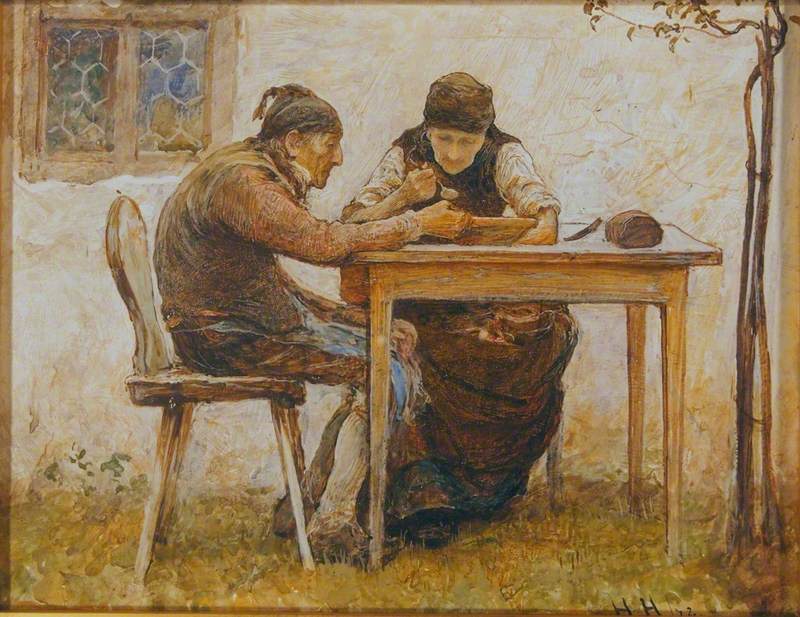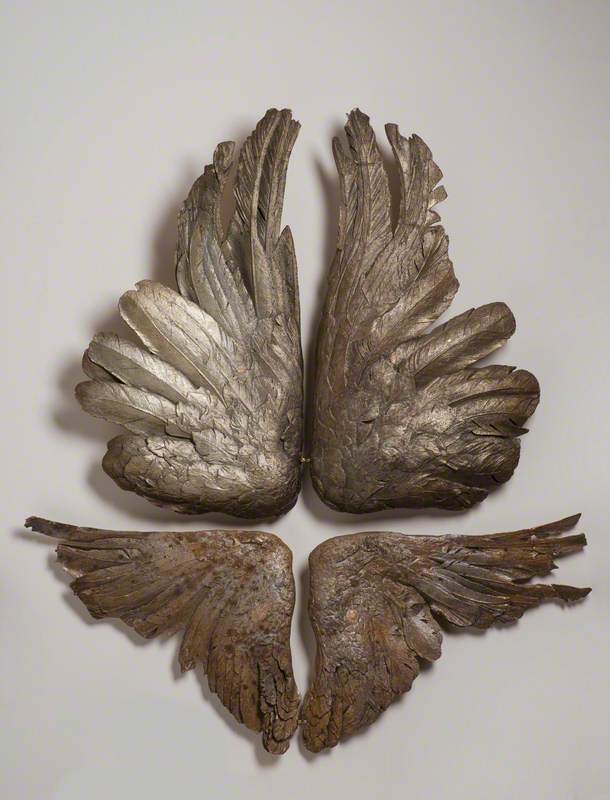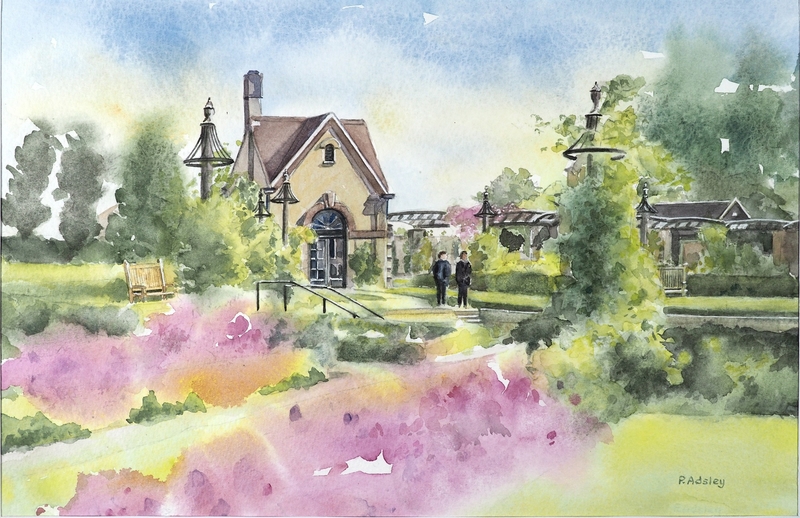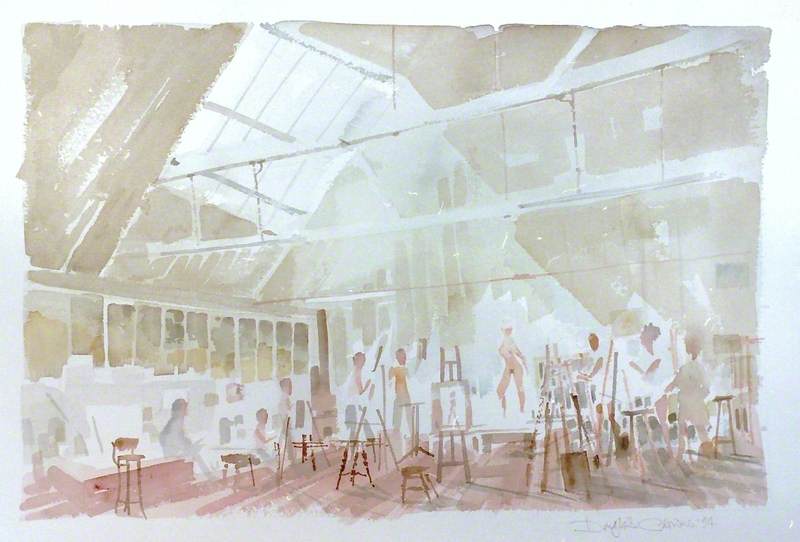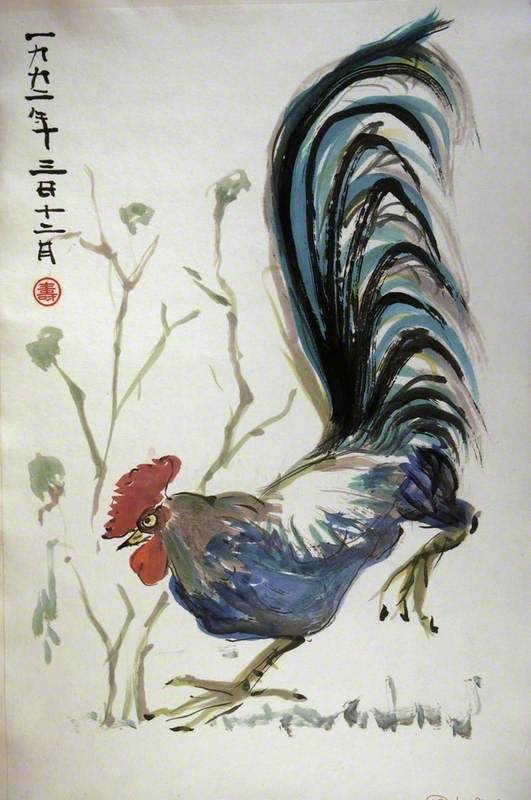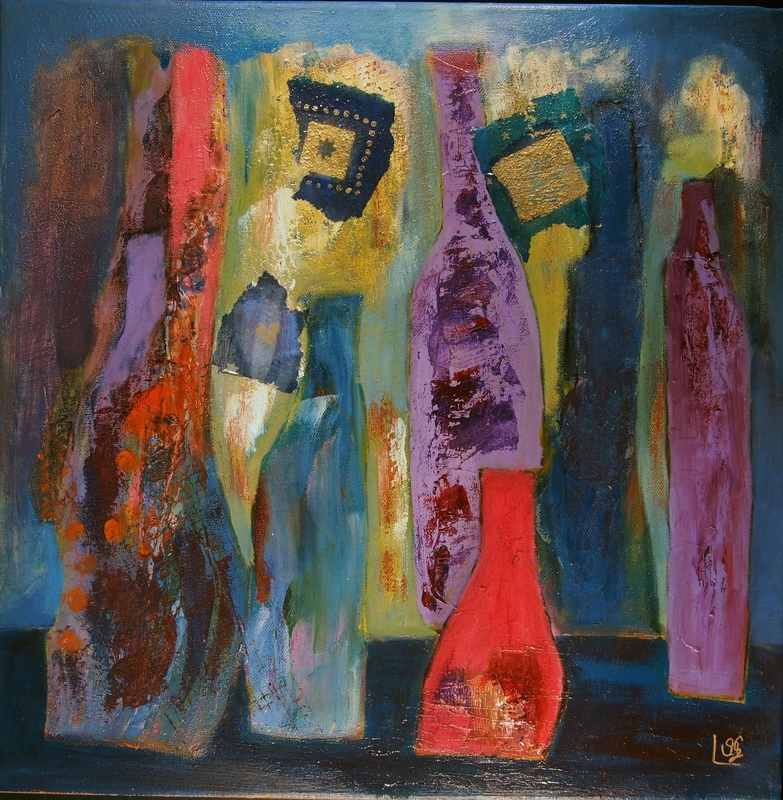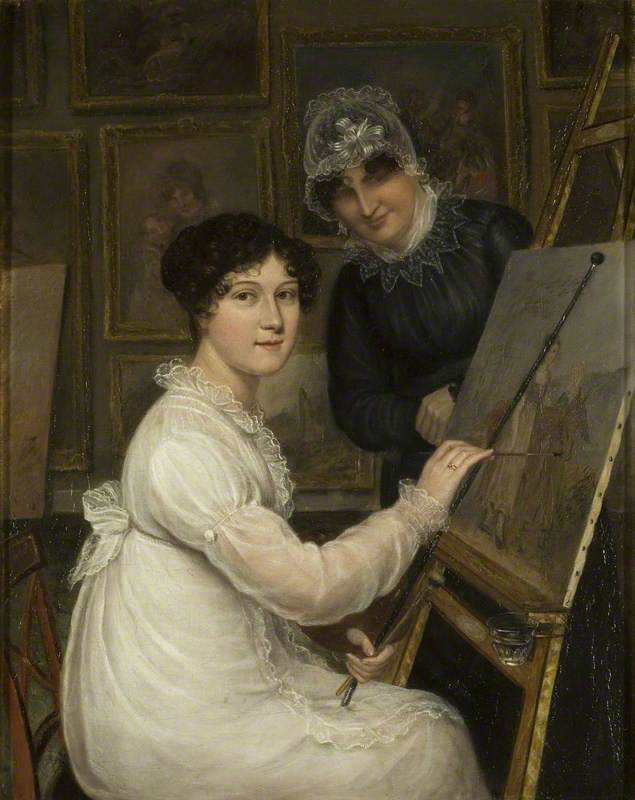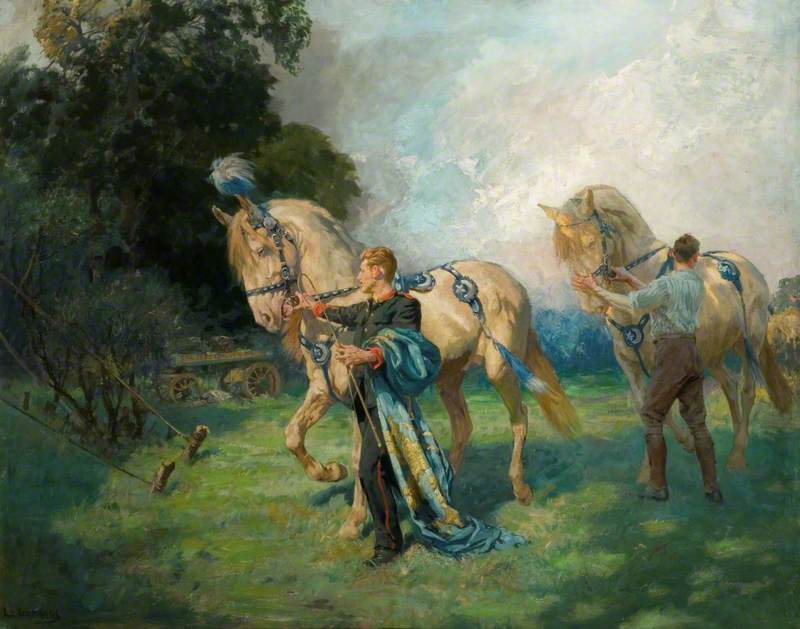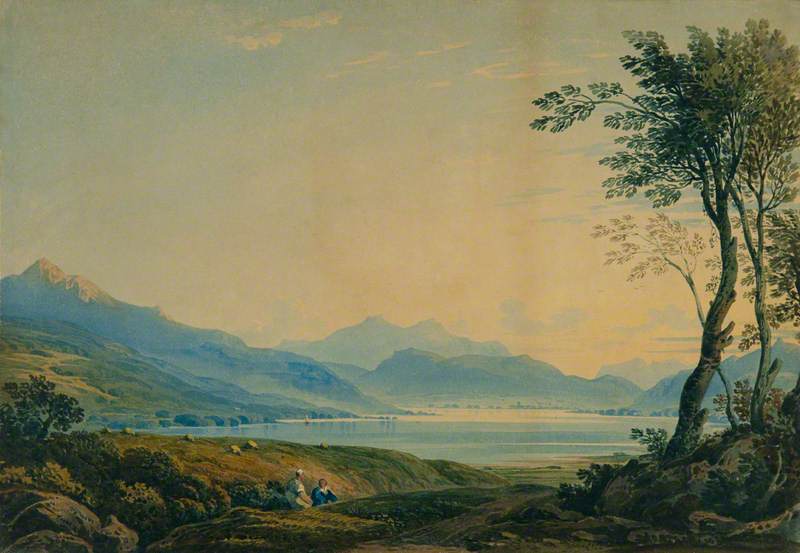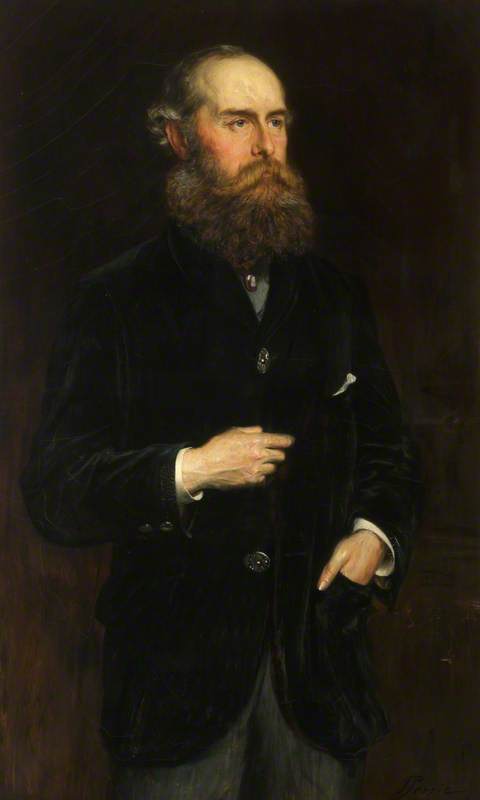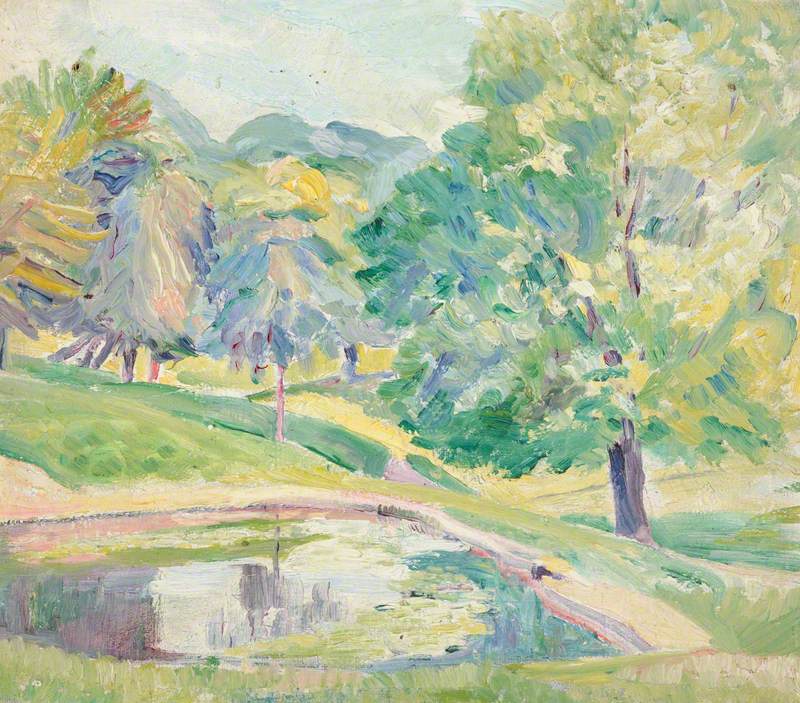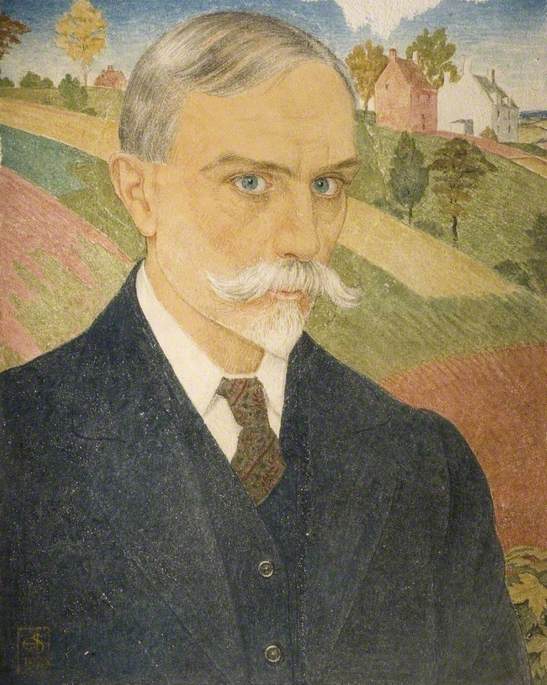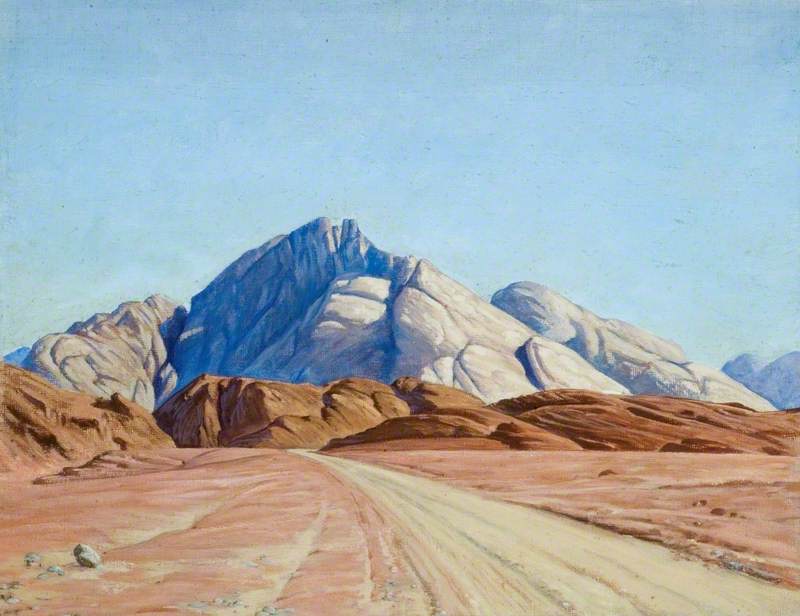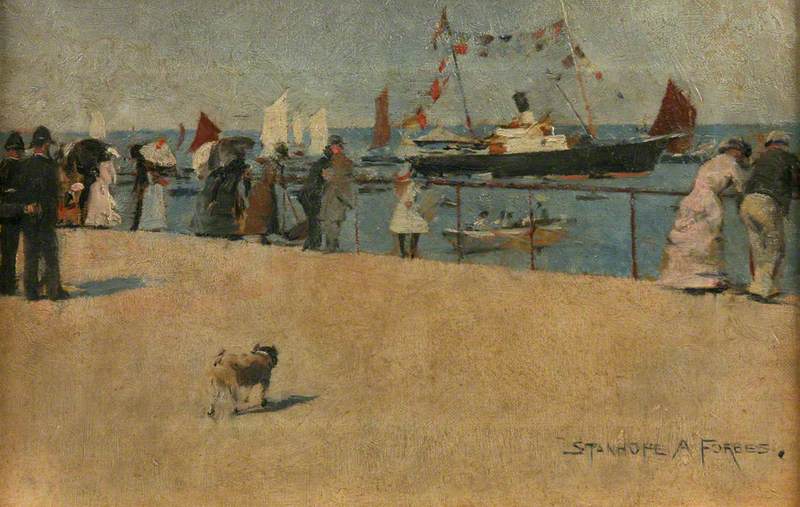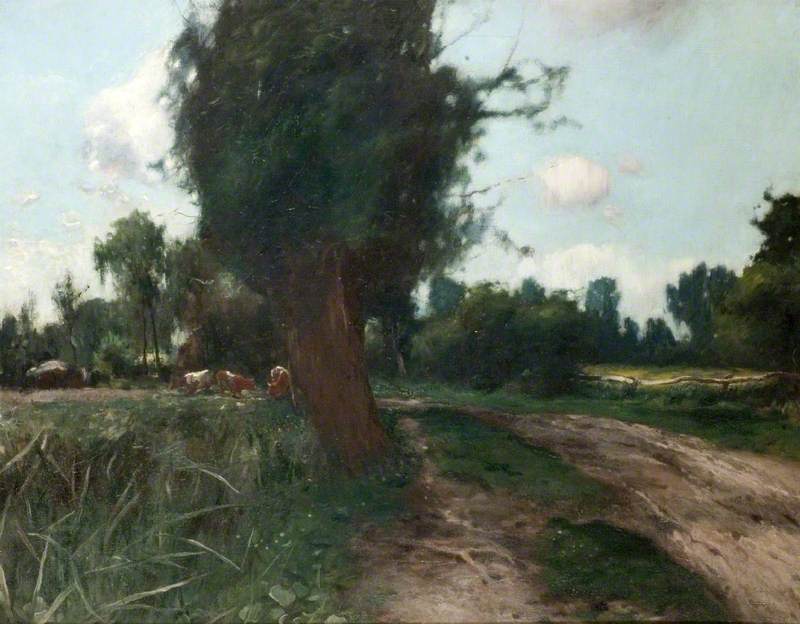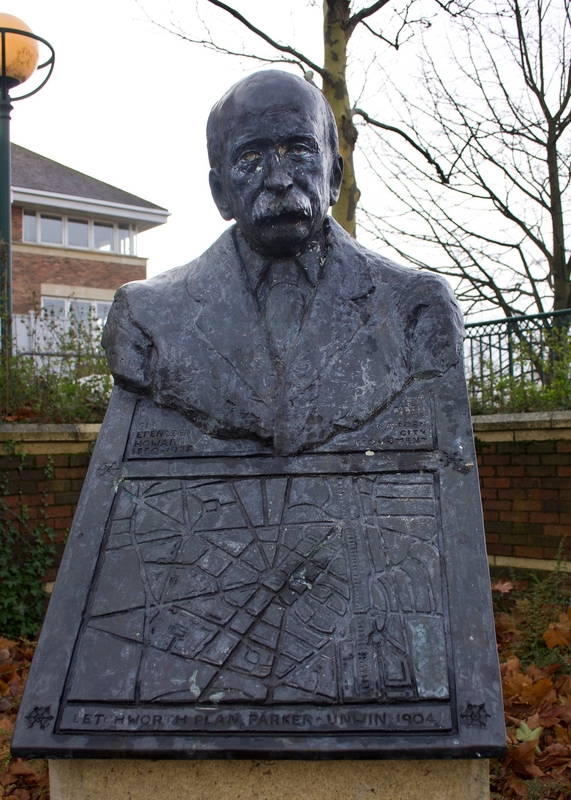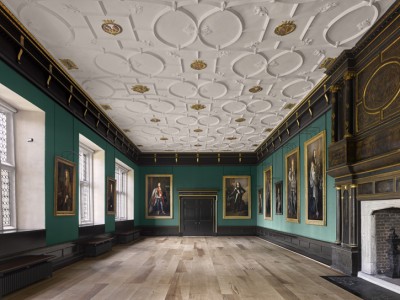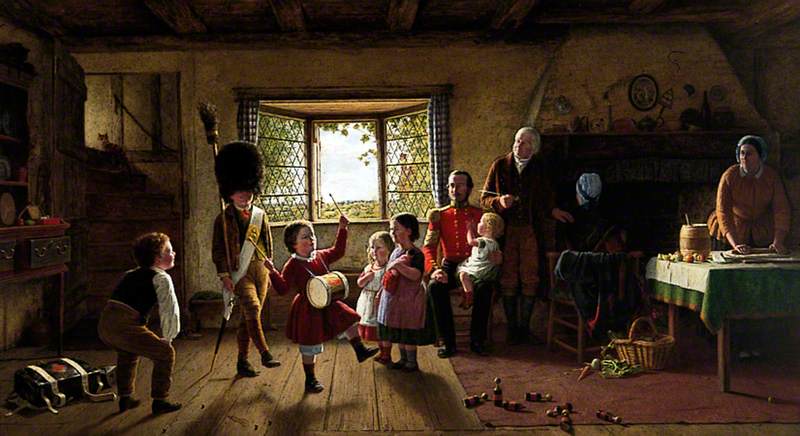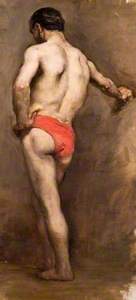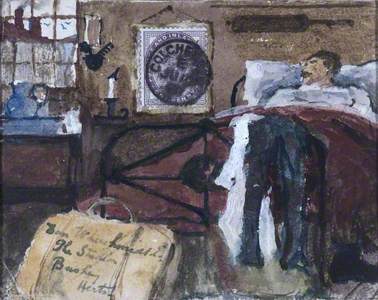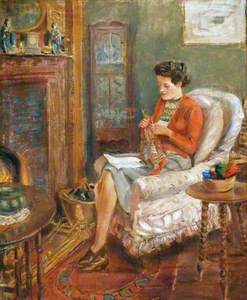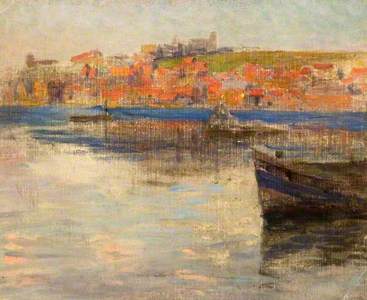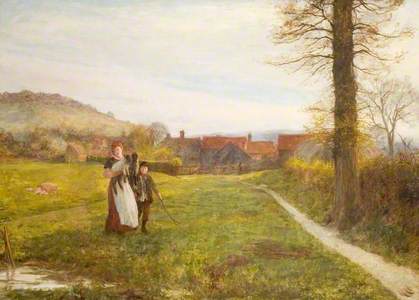Bushey, just 15 miles north of London, is mentioned in the Domesday Book. With its attractive broad views over meadow and pasture looking towards the Colne valley, the village, with its parish church and pond, retains the atmosphere that has drawn many artists to work and live here over the years.
Thomas Monro (1759–1833), made Principal Physician in 1792, was an art collector and patron. At his London address, Adelphi Terrace, he encouraged budding young artists, such as Peter de Wint, Louis Thomas Francia, John Sell Cotman, Thomas Girtin and J. M. W. Turner to work, for half a crown and their supper, copying artists such as Richard Wilson, Thomas Hearne and J. R. Cozens. In 1805 Monro acquired a cottage orné in Bushey as his country residence.
Artists recorded as visiting the cottage include James Bourne, Peter de Wint, Thomas Girtin, William Henry Hunt, Thomas Hearne and Henry Edridge. Turner may also have visited, as his patron, the Earl of Essex, lived in nearby Cassiobury House, Watford.
Monro was himself an amateur artist, as were three of his sons, Henry, Alexander and John. In devoting himself to training young artists in watercolour landscape painting, Monro made a significant contribution to the golden age of watercolour painting in Britain. Renowned for his kindness, generosity and sensitivity, he welcomed artists to his Bushey residence, which offered them the opportunity to sketch the undulating countryside. Monro is buried in St James' churchyard in Bushey, alongside Thomas Hearne and Henry Edridge, whose funerals and burials he paid for.
The artist Hubert von Herkomer (1849–1914) arrived in Bushey 40 years after Monro's death, probably to be near his patron, Clarence E. Fry, who lived near Bushey Station.
Herkomer acquired a house in Bushey High Street next door to Eccleston Gibb, whose ward, Annie Salter, had aspirations to be an artist. Although Herkomer declined to teach Annie, he offered to teach groups of students free of charge at an art school that Gibb agreed to pay for. The school opened in 1883 and existed until 1904 when Herkomer sold the building to his prize student, Lucy Kemp-Welch (1869–1958).
Herkomer was born in Waal, a village near Landsberg am Lech in Bavaria. His father and uncles emigrated to America to find work but were unsuccessful and returned to Southampton when Hubert was eight, where his mother's ability to play the piano saved them from destitution. Herkomer was a sickly child, and consequently was taught at home by his parents.
Herkomer Cross from St James's, Bushey
Hubert von Herkomer (1849–1914) 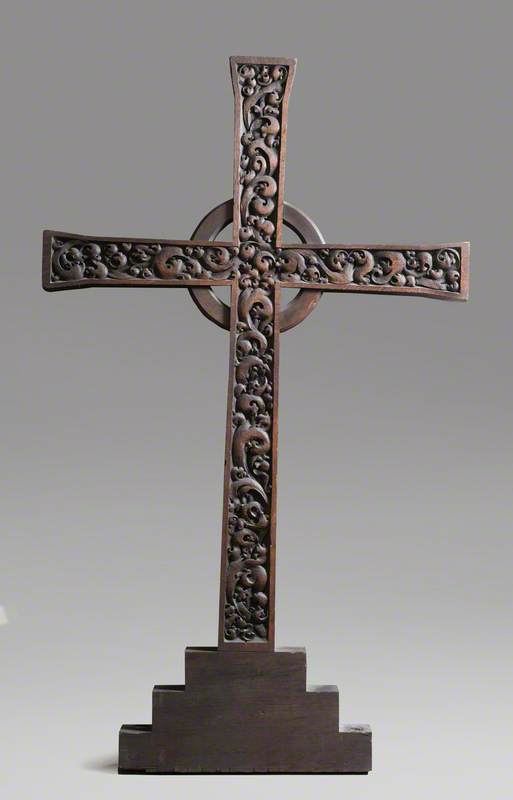
Herkomer's artistic skills developed rapidly. He learned to carve, engrave and draw and at the age of 14 attended Southampton School of Art, followed by the Munich Academy. In 1866 he enrolled at the National Art Training School, forerunner of the Royal College of Art. He gradually began to obtain work on magazines and was engaged by the owner of The Graphic, William Luson Thomas – a wood engraver and a social reformer. Having had a poor childhood himself, he wanted to describe and illustrate urban squalor and instructed his employees to 'go out into life and humanity'. Herkomer's fellow illustrators were Luke Fildes and Frank Holl who were exponents of British Social Realism.
These illustrations deeply impressed and influenced Van Gogh who owned a complete run of 21 volumes of The Graphic from between 1870 and 1880. He admired Herkomer's vigorous contours, his composition, structure and spatial approach, as well as his writings on art. Herkomer's Royal Academy submission in 1875 at the age of 26 was The Last Muster, an oil painting worked up from one of his black and white illustrations for The Graphic. A great success, it made him an instant celebrity. It is now in the collection of Lady Lever Art Gallery, Merseyside.
The Last Muster, Sunday at the Royal Hospital, Chelsea
1875
Hubert von Herkomer (1849–1914) 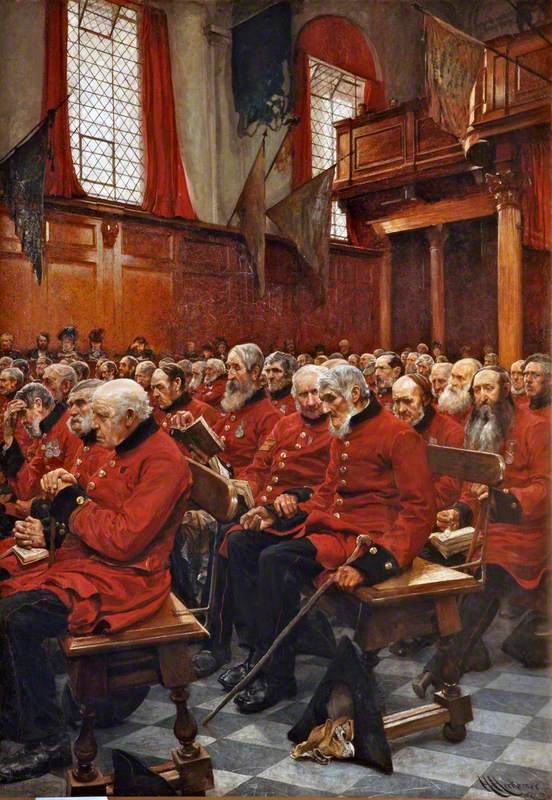
Herkomer's dexterity in delineation was enhanced by his treatment of light and shade – an important factor in his engraving work. His viewpoint varied, but often he gave areas of space an exaggerated perspective, accentuating winding roads. His work almost always foregrounds human interest, generally groups of people acting out the drama of life, working, dancing, socialising and experiencing loss, despair, helplessness and inertia.
His broad brushstrokes for background and finely detailed subject matter lend a theatrical significance to his interpretation. He was a successful portraitist because he knew how to style and light his subjects professionally.
Sir Hermann David Weber (1823–1918)
1902
Hubert von Herkomer (1849–1914) 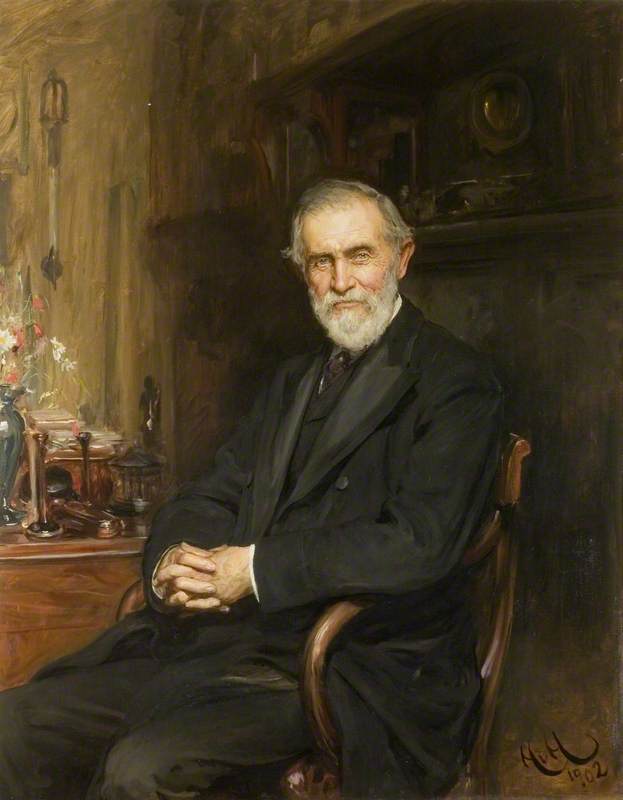
The Herkomer School opened with 17 male and 15 female students, all instructed to find lodgings in the village, thus providing income for the residents, many of whom suffered poverty and hardship. Villagers also posed as life models. Over 500 students passed through the school in its lifetime. The Professor shunned traditional art-school teaching, but was nevertheless a hard taskmaster.
Men and women were separated for life classes but otherwise often worked together – something unknown in other art establishments. There were strict rules for student working hours, smoking was forbidden and trips to London were limited to Saturday afternoon or Sunday. Herkomer's prime concern for all students was that they treat their work seriously and any female student who became engaged or married was instantly dismissed, in case of distraction.
Because students were obliged to live in Bushey, gradually students acquired their own studios and the village became a mini art colony. In 1892 Herkomer arranged for temporary studios to be erected on Bushey High Street to aid the students in their work. Meadow Studios became an integral part of the artistic community in later years.
Herkomer demanded total dedication to his innovative teaching methods, and largely disregarded what was happening at the time in European art. His students practised a diverse range of artistic pursuits, learning etching and engraving, including mezzotint, enamelling and theatre work. Herkomer converted a former chapel into a theatre where he created dramatic tableaux, considering it another method of picture-making. He brought in technical innovations such as lighting from the wings and is said to have influenced the great theatre designer Edward Gordon Craig. Around 1912, he converted the theatre into a film studio.
As Herkomer's reputation grew, his portrait commissions proved lucrative, enabling him to build a house in Bushey. Named Lululaund, after his second wife Lulu, it was designed by the American architect Henry Hobson Richardson, with considerable input from Herkomer. A fantasy building made up of tufa stone, shipped from Bavaria, with entrance gates designed by Giles Gilbert Scott, the grand interior was a mixture of neo-Gothic and Art Nouveau with Arts and Crafts. His father and uncles created the wood carvings, hangings and furnishings and there were flickering electric lights throughout. Lululaund unfortunately was demolished in 1937.
In 1912 Herkomer ordered the school buildings to be demolished and replaced by a rose garden designed by Thomas Hayton Mawson, the most celebrated landscape architect of the Edwardian era and a leading exponent of the Arts and Crafts Movement. Bushey Urban District Council bought the garden in 1937 and it was opened to the public in the same year. It is today a favourite spot for local artists, practising their landscape skills.
In 1905 Lucy Kemp-Welch took on Herkomer's Art School, changing the name to The Bushey School of Painting, but chose to delegate other people to run the organisation. When Herkomer arranged for his school building to be demolished, Lucy set up a glass studio in the orchard of her house, Kingsley, opposite the parish church.
Herkomer died in 1914, just before the First World War began. Lucy Kemp-Welch, although unable to work on the front line, produced recruiting posters, painting battle manoeuvres on Salisbury Plain and recording the preparation and care of horses for war work. By the end of the war she had appointed her student Marguerite Frobisher (1890–1974), as her secretary, and relinquished most of the day-to-day running of the school to her. It was renamed The Kemp-Welch School for Drawing and Painting in 1922.
A number of Herkomer's students took the opportunity to practise their teaching skills and Lucy Kemp-Welch was ably assisted by Rowland Wheelwright (1870–1955) and John William Whiteley (1860–1936), the latter taking Canadian artist Emily Carr as a pupil when she first arrived in Bushey.
Marmaduke Flower and his son Clement Flower ran the Bushey School of Portraiture and Illustration and George Harcourt, master of the Herkomer School preliminary classes, maintained a close connection with Bushey, latterly teaching at the Royal Masonic School.
The British and Irish Spinning and Weaving and Lace School established a branch in Bushey and William Maitland, a woodcarver who had acted as a technician when Herkomer launched his film-making, became Principal of the Bushey Guild of Handicraft. For many years, Joseph Wilson Forster, a painter, illustrator and worker in stained glass, ran a school of Arts and Crafts.
Interior of the Frobisher Studio, Bushey
Margaret B. Spark (1927–2002) 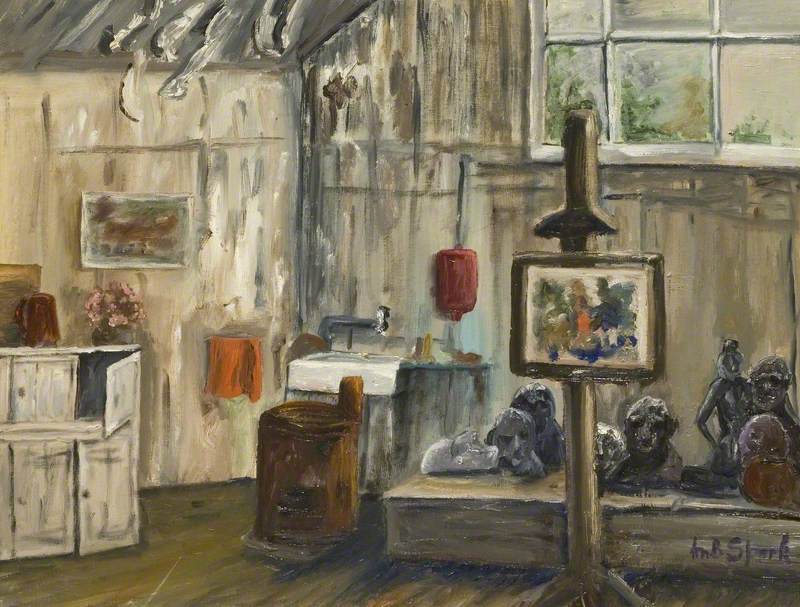
When in 1926 Lucy Kemp-Welch gave up teaching altogether, Marguerite Frobisher, with Lucy's permission, opened her own school. The Frobisher School of Art flourished well into the 1970s. The Studio building was transferred to the Bushey Museum site in 2006 and a range of painting, drawing and printing classes continue there.
During the 1920s and beyond Bushey continued to be a thriving centre for artists, many of whom retained a connection to the Herkomer school. Many Herkomer alumni proceeded to take up their palettes and travel, either throughout the British Isles or abroad, but a number remained in Bushey, at least for a period.
Arthur Leonard Cox (1879–1961)
1944
Ernest Borough Johnson (1866–1949) 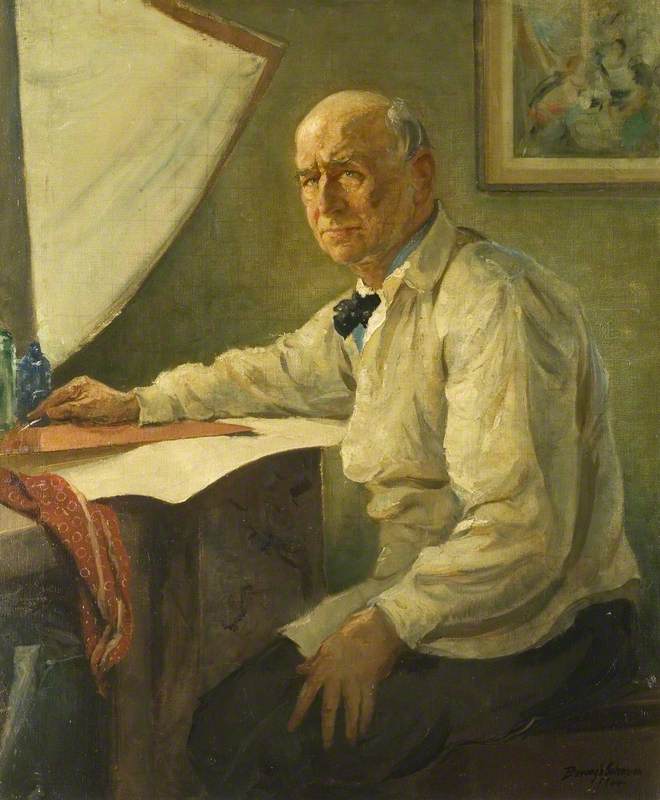
Herkomer had gained respect from his fellow artists and his ideas about art education were percolating through burgeoning art establishments. Bushey's art colony had developed a reputation not only for good teachers but also – very important to any aspiring artist – good art studio accommodation.
After the Second World War, printing became the most important industry in the area but a band of qualified artists took to working in Meadow Studios in Bushey. The studios were eventually demolished in the 1970s, but for a time they were a hub of thriving artistic experimental talent.
Old Frank’s Studio: Interior No. 3, Meadow Studio, Bushey
1955–1956
John Rosser (b.1931) 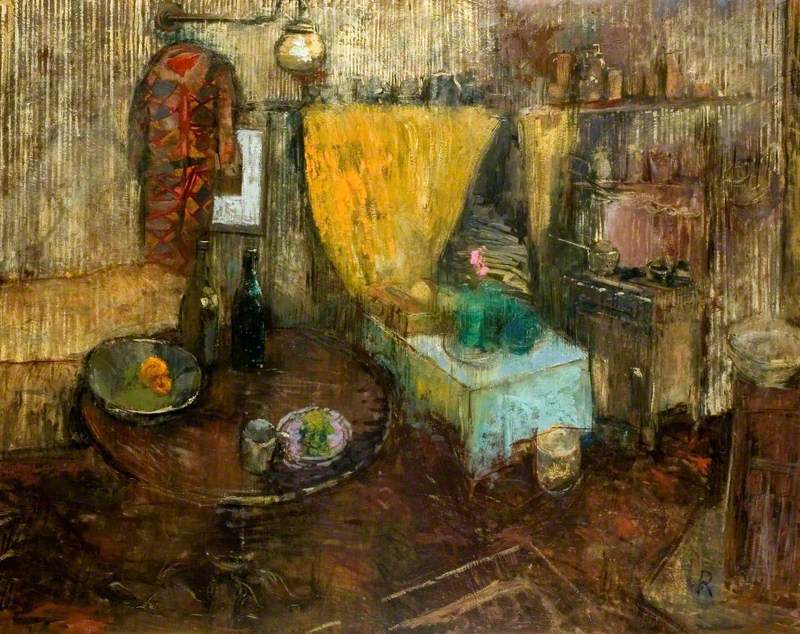
When Bushey Museum opened in 1993, a room featuring Hubert von Herkomer was a priority. It is now a permanent feature of the Museum, but is not allowed to become immutable. As the Museum adds to its collection and interests change, so the story of Herkomer is related in varied ways.
Before she died in 1974, Marguerite Frobisher, together with the Parochial Church Council, opened the Lucy Kemp-Welch Memorial Gallery in Bushey. A collection of Lucy's paintings were transferred to storage for safekeeping but in 2007 it was agreed that the paintings should be on show in Bushey Museum and the Lucy Kemp-Welch Gallery is devoted to her work.
Bushey Museum has a varied exhibition programme. The extensive and diverse collections enable exhibitions to feature a wide variety of individual artists, different media and subject matter.
Local schools and art societies are invited to exhibit their artwork and a number of local artists are involved with the running of Bushey Museum.
Bushey Museum can rightly claim that the essence of its art colony follows a continuum from the days of Dr Monro. From the Church to the Rose Garden to the architecture of the buildings, Bushey can boast a unique history of visual art.
Pat Woollard, curator at Bushey Museum

